2025 Raid® State of the Bug Report
A science-backed look at the pest species shaping 2025 – where they’re showing up and what it means for daily life nationwide
Bugs have been around for hundreds of millions of years – long before humans – and they greatly outnumber us too, with an estimated 1.4 billion insects for every person on Earth1.
While the vast majority of insects play a vital role in our ecosystem as decomposers, pollinators and natural pest controllers, a small fraction – roughly 3% of known insect species – are considered pests2. These bothersome species start to become a nuisance and can disrupt peace of mind when congregating into homes, and in certain cases, can create a danger or health hazard if they bite or are known to transmit harmful diseases.
Today, insect populations around the world are changing, with some declining due to habitat loss and climate shifts, while others, like invasive species, are spreading into new regions. These ecological shifts are already impacting where and when pest problems surface, making proactive prevention more important than ever.
The SC Johnson Center for Insect Science and Family Health, one of the largest privately held entomology centers in the world, has dedicated over 65 years to studying insect behavior and distinguishing myths from true household threats. This research has powered the science-backed pest control product development of Raid® products, designed to help families confidently tackle bug problems in and around their homes.
With more than 15 million insects reared annually3 and over 100 species studied in 2024 alone, Raid® brought in their expert entomologists from the Center for Insect Science and Family Health to share the top emerging pests (and familiar offenders) that Americans should watch for in 2025:
Additional details
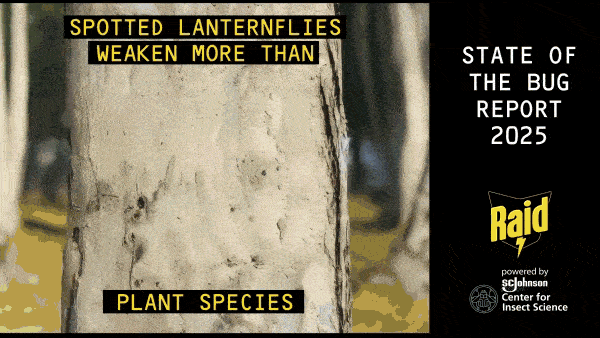
Native to Asia and emerging in the United States, the spotted lanternfly is an invasive sap-sucking insect that feeds on and weakens more than 70 plant species4, posing a significant threat to agricultural crops, hardwood trees, grapevines and more. Spotted lanternflies also excrete large amounts of sticky honeydew that attract other insects and promote the growth of sooty mold, reducing the plant’s ability to photosynthesize and grow. As such, the United States Department of Agriculture (USDA) recommends squashing spotted lanternfly eggs on sight5 to prevent the spread of this invasive planthopper.
Spread: This hitchhiking pest is primarily found on trees and spreads through human activity by laying eggs on vehicles, firewood, outdoor furniture, and stone, which inadvertently transports them to new areas.
Impacted Regions: First discovered in Pennsylvania in 2014, this is an invasive species that is found in 18 U.S. states today. It’s emerging along the east coast in states like New York, New Jersey, Massachusetts, Connecticut, Maryland and Virginia, and expanding westward to states like Ohio, Kentucky, and Illinois.
What This Means for Your Home & What to Do: Spotted lanternflies can damage the trees and plants around people’s homes, which is why the USDA recommends regularly inspecting trees and plants for signs of this sap-sucking pest, while looking for their egg masses in trees, bricks, stones and other smooth surfaces. When traveling, be cognizant of quarantine areas and thoroughly check your vehicle and clothes to ensure these pests don’t hitchhike and spread to new land. If you spot lanternfly eggs, take the following steps, per the USDA:
- First, smash the eggs and scrape them into a plastic zippered bag filled with hand sanitizer or rubbing alcohol to kill them.
- Then, zip the bag shut and dispose of it in the trash.
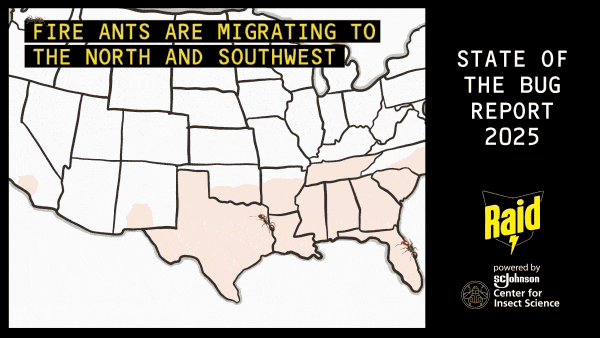
Relatively new to the United States and introduced from South America decades ago – likely through soil in cargo ships6 – fire ants are an aggressive ant species with painful stings that can cause allergic reactions and can even be life-threatening in some cases7, especially when exposed to multiple stings or an entire fire ant mound.
Spread: Fire ants are starting to hybridize with other ant species, creating the possibility for them to adapt and spread beyond the Southeastern U.S.
Impacted Regions: Primarily found in Southeastern U.S. but expanding north along the Atlantic Coast to Virginia and appearing in the desert Southwest, including New Mexico and California.
What This Means for Your Home & What to Do: Fire ants generally build colonies outdoors and mounds can sometimes be found under rocks or wood laying on the ground.
Make sure to remove debris—such as wood, rocks, and stones—that are close to the foundation of your home where fire ants may build an invisible colony. A combination of residual sprays, mound treatments and baits are recommended to help get rid of fire ants, but if there are too many mounds to handle yourself or if there is a medical reason to avoid stings, consider hiring a professional yard maintenance company for help.
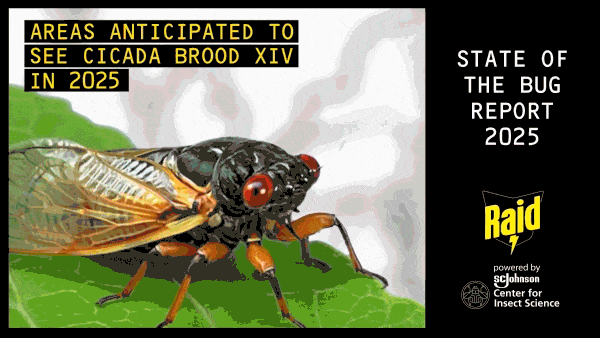
Periodical cicadas are a unique phenomenon, with broods emerging every 13 or 17 years depending on the species. In 2024, both Brood XIX and Brood XIII surfaced simultaneously – a first in over 200 years. In 2025, Brood XIV is expected to emerge, bringing another wave of cicadas to parts of the Midwest and Eastern U.S.
Spread: When soil temperatures hit ~64°F at a depth of 12-18 inches8, cicadas emerge from the ground in large numbers. They climb nearby trees or structures, shed their exoskeletons and begin mating as adults.
Impacted Regions: Brood XIV cicadas are expected to emerge this year across parts of Massachusetts, New York, Pennsylvania, Virginia, West Virginia, Georgia, South Carolina, Tennessee, Kentucky, Ohio, and Indiana, as well as possibly along the edges of Illinois, Maryland, and Washington, D.C. Areas with long standing tree growth will see the most activity. Areas without longstanding tree growth will have little impact.
What This Means for Your Home & What to Do: While cicadas are generally not harmful to humans and don’t bite, sting or carry diseases – the noise of their mating call can be jarring and it can be uncomfortable when they land on you. To keep periodical cicadas out of your home, be sure to seal entry points and close chimneys and attic vents.

A common culprit in homes, hotels, and public transportation, bed bugs are a persistent household pest with serious public health implications. According to the U.S. Environmental Protection Agency (EPA), they fall under the category of blood-sucking ectoparasites – similar to head lice – due to their invasive nature and bites, which can cause itching, sleep disruption and allergic reactions that can lead to physical and mental stress.
Spread: Bed bugs tend to be more active in the summer months due to warmer temperatures and increased human travel, which can facilitate their spread and allow them to reproduce faster. Bed bugs mainly spread by hitchhiking on various items like luggage, clothing, furniture and bedding. In multi-unit buildings, they can travel between units through cracks, crevices, shared items and even shared systems, like plumbing and electrical wiring.
Impacted Regions: Found across the U.S., with infestations especially common in major cities and densely populated areas.
What This Means for Your Home & What to Do: Due to the invasiveness of bed bugs and their itchy bites, these pests can be a real problem in homes. It is important to do regular inspections, wash your bedding and suspected clothes in hot water and vacuum the room thoroughly. To further protect your home, check mattress seams and bedframes regularly and get rid of them appropriately if they exhibit any signs of bed bug infestation such as rust-colored stains, a musty odor or cast skins. For persistent infestations, Raid Max® Bed Bug Foaming Spray can be used on mattresses, bed frames, upholstered furniture and carpet for protection up to 4 weeks.
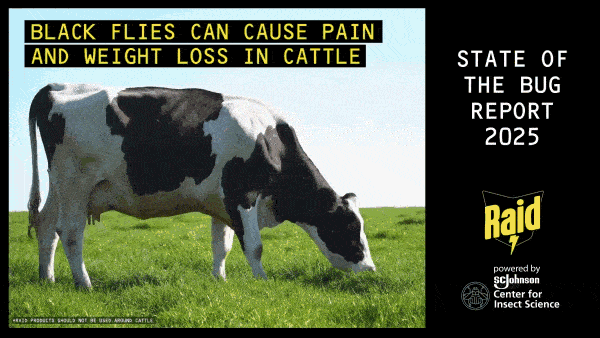
Primarily active from late April to July, female black flies gain nourishment by feeding on the blood of mammals, including humans and birds. Their bites are painful and often cause itching and swelling. In cattle, they can lead to weight loss. For those who travel to parts of Africa, black flies can also transmit a disease known as “river blindness.”
Spread: Black flies lay eggs in flowing water like rivers and streams. Adult flies can fly several miles from their breeding site and often swarm around potential hosts, like humans or other animals.
Impacted Regions: Primarily found in the wetter parts of the northern U.S. and Canada, including New England, Minnesota and the Upper Peninsula of Michigan.
What This Means for Your Home & What to Do: For people in the northern U.S. with homes near rivers or areas with consistent rainfall, install fine mesh screens and use fans on porches or patios, as black flies avoid breezy areas.
To alleviate bites, wash the affected area with soap and water and apply antihistamines or hydrocortisone cream to reduce itching and swelling. Additionally, apply an effective antiseptic to help with pain relief and to stop bacteria from spreading.
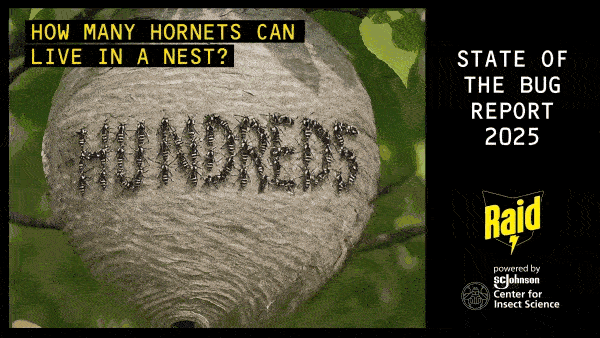
With warmer winters and longer growing seasons emerging in parts of the U.S., bald-faced hornets could show up earlier and nest in greater numbers, raising concerns for both homeowners and outdoor workers. These stinging insects are distinguished by their larger size and have a striking black and white coloration. They can often be aggressive, especially when their nest is disturbed.
Spread: Nests start in early spring but are usually found in mid-late summer while mowing around bushes and trees, or in the fall when fallen leaves expose the nests. Nest inhabitants can number in the hundreds by late summer.
Impacted Regions: Found in most of the United States and Canada, but most abundant in the Southeastern U.S. These insects prefer forested areas with consistent rainfall but can also be found in urban areas.
What this Means for Your Home & What to Do: Most bald-faced hornet nests can be found in trees and shrubs but may show up under eaves or other sheltered areas like attics or wall voids.
If you spot these stinging insects around the home, stay away from their nest and avoid swatting at them, as they are highly aggressive and can sting multiple times. Be sure to inspect the perimeter of your home regularly to prevent nesting, but if these insects persist, use Raid® Wasp & Hornet Killer 33, which kills wasps and hornets on contact and allows you to spray up to 22 feet, killing the entire nest.

After a population surge reported in 2024 fueled by mild winters and heavy rainfall in states like Wisconsin and Michigan, earwigs could remain unusually active in 2025, especially in areas with wet spring conditions. Earwigs, also known as pincher bugs, are popular in folklore due to the common – but untrue – myth that they crawl inside your ears to lay eggs or feed on your brain. Their large pincers on the end of their abdomen are mainly used in defense, meaning they can pinch but usually won’t attack humans unless disturbed.
Spread: Earwigs are attracted to moisture and tight spaces, so they may seek out damp areas, eventually finding entry points into homes.
Impacted Regions: Common throughout the U.S. although states like Wisconsin, Michigan and upstate New York reported increased populations in 2024 due to a milder winter and higher precipitation.
What this Means for Your Home & What to Do: For earwigs that have made their way inside the home, reduce moisture, seal entry points, and use insecticide in cracks and crevices where they hide.
For outdoor areas, eliminate debris and mulch near the foundation, and use natural deterrents like diatomaceous earth to control their presence in gardens. Alternatively, use Raid® Ant & Roach Killer 26. It is formulated to kill pests like earwigs on contact and can be applied to surfaces where the bugs may be infesting.

A large mosquito species, gallinippers emerge in large numbers after heavy rainfall and flood events, especially hurricanes. These mosquitoes are highly aggressive with painful bites. Unlike some mosquito species, gallinippers are not known to transmit vector-borne diseases to humans – however, they may be able to transmit heartworm to dogs. While not unique to 2025, because hurricane seasons are expected to continue expanding in duration and intensity (which could lead to more major rainfall events) in the coming years9, gallinippers may have an extended presence moving forward.
Spread: Gallinippers emerge in large numbers after major rainfall events between May and October. People often report swarms of these aggressive and shockingly large mosquitoes after hurricanes.
Impacted Regions: Eastern half of the U.S., especially Southeastern states like Florida, Georgia, North Carolina and South Carolina, as well as other regions around the Gulf.
What This Means for Your Home & What to Do: For homeowners who notice the emergence of gallinippers and other mosquitoes after a heavy rainfall, use Raid® Yard Guard Mosquito Fogger in addition to wearing protective clothing like long sleeves and an EPA-registered repellent to reduce the risk of getting bit. It’s also recommended to clean gutters and ensure proper yard drainage around the home.
Conclusion: If you spot any insects in and around your home, use Raid’s® ‘Find The Bug’ feature as a first step resource to learn more and identify a Raid® solution to help you take back control of your living space and peace of mind.
For unique or less common insects not specified on a Raid® product label, conduct research online or consult a local pest control professional to determine the best course of action.
Sources:
1 Macneal, Bugged: The Insects Who Rule The World And The People Obsessed With Them (2017).
https://archive.org/details/buggedinsectswho0000macn/mode/2up
2
National Pesticide Information Center
. Beneficial Insects. Last updated January 29, 2025
3
SC Johnson
. Insect Science: Helping Families Stay Healthy by Fighting Mosquito-Borne Disease. May 16, 2022
4
New York State Department of Environmental Conservation
. Spotted Lanternfly. Retrieved April 29, 2025
5
U.S. Department Of Agriculture, Animal and Plant Health Inspection Service
. Spotted Lanternfly. Last updated January 13, 2025
6
U.S. Department of Agriculture, Animal and Plant Health Inspection Service
. Imported Fire Ants. Last updated October 1, 2024
7
Cleveland Clinic
. Fire ant bites. Last updated June 28, 2022
8
The Nature Conservancy
. Everything You Need to Know About Periodical Cicadas. Last updated April 14, 2025
9
NOAA Atlantic Oceanographic & Meteorological Laboratory
. New NOAA research predicts an increase in active Atlantic hurricane seasons. November 18, 2024

